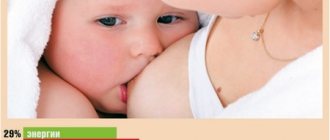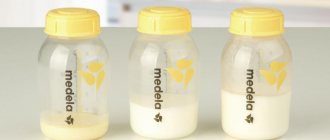Main features
How can you tell if your baby is getting enough breast milk? One of the main criteria is calm behavior and normal development of the baby. If he sucks the breast with pleasure, falls asleep well, and is cheerful and active while awake, most likely he has enough milk. Other signs that indicate successful breastfeeding include:
- application frequency. Lactation consultants recommend feeding your baby on demand during the first 1-2 months of life. Depending on the individual characteristics of such “approaches” there can be from 8-10 to 12 per day. Then, as the baby grows, a regimen of 6-7 feedings per day is formed every 3-3.5 hours and possibly with a night break.
- duration of sucking. It also depends on the age and condition of the child. For some, 10 minutes is enough, while others suck for half an hour. On average, 20 minutes is considered enough. But you should not limit feeding to a strictly defined period. Having eaten, the baby will release the breast on its own;
- presence of a swallowing reflex. Notice how your baby sucks at the breast. If he actively swallows and does not use the breast as a pacifier, then everything is in order and the baby is getting enough milk;
- weight gain according to age. In the first months, the child gains an average of 600 to 800 grams, sometimes up to 900 and 1000 g. You can determine sufficient weight gain with regular visits to the pediatrician;
- number of urinations and bowel movements. If a baby over 7 days old urinates at least 8–12 times and has clear, odorless urine, it means he has enough milk. The number of bowel movements is from 1 to 6-7 times a day.
Is the baby getting enough breast milk?
All parents want their children to grow up healthy and happy. While the baby is just a baby, the concept of health and happiness is closely connected with how much nutrition the child has. Therefore, many mothers may be faced with the question: how to determine whether the baby is getting enough nutrition? This question is especially often asked by mothers who are breastfeeding. How do you know if your baby is getting enough to eat? How long should a baby stay at the breast ? Is there really not enough milk ? the child crying from hunger or for another reason? What to do if a child “uses the breast as a pacifier” ? We will try to answer these and many other important questions!
In fact, there are only two reliable ways to determine whether a mother has enough milk:
- Child's weight gain per week: from 125g or more.
According to the World Health Organization child weight tables, healthy babies gain from 500 g to 2 kg for each of the first 6 months of life. If the child is not gaining anything , or is not gaining enough weight , this is a reason to look for errors in the organization of breastfeeding or contact a breastfeeding specialist.
- Number of urinations per day: 12 or more.
A child who receives nothing other than mother's milk directly from the breast must pee at least 12 times per day. You need to count urination without a diaper, diapers, rompers, panties. If a child pees a little , this is a reason to think about how correctly breastfeeding is organized and, if necessary, correct those points that cause difficulties. As a rule, first of all, it is advisable to start putting the baby to the breast more often and check how well the baby latch onto the mother's breast.
All other signs are unreliable and cannot help the mother determine whether the baby is eating.
Let's look at the most common methods that mothers mistakenly use:
- Feelings in the chest:
- milk rushes are not felt
Breasts don't fill up between feedings
- breasts did not change during pregnancy
- Amount of expressed milk.
This is a very popular method for determining the amount of milk in the breast , but, unfortunately, it is also not reliable. Our breasts are designed in such a way as to produce the greatest amount of milk in response to the baby sucking at the breast, provided that the attachment is correct. When we apply pressure to the areola with our hands or a breast pump, the hormonal processes necessary for milk production are much weaker, and as a result, many mothers can express literally drops. So if you can’t express milk , this does not mean that there is no milk in the breast.
- Control weighing before and after feeding.
Control weighings are still carried out in clinics - and, alas, are not a reliable way to determine the amount of milk. When a child is fed on demand, he knows that as soon as I ask, the mother will always breastfeed. And he sucks not only to eat and drink, but also to satisfy all his needs: while sucking at the breast, the child’s urination and bowel movements are easier, it’s easier for him to calm down and learn new information, and any stress goes away without a trace. Accordingly, the amount of milk sucked by the child varies from feeding to feeding and even during the day, and control weighings are not indicative.
- Baby's behavior at the breast and between feedings.
The mother draws conclusions about the lack of milk in the breast by the baby’s behavior at the breast and between feedings. For example: at first the baby willingly takes the breast, sucks for several minutes, and then breaks away and cries, takes it again and throws it away again. This behavior is very easy to mistake for anger from hunger, as if the chest is empty, there is no milk . In fact, as soon as the child attaches to the breast, the hormonal processes of milk production immediately begin, that is, milk appears in response to the child sucking the breast; demand creates supply. And the example of behavior at the breast described above is most often refusal behavior due to the use of breast substitutes - pacifiers, breast shields, bottles, the so-called nipple confusion. The child is angry not because he is hungry, but because he wants to suckle at the breast in the same way as a bottle and pacifier, but he cannot. The child is confused and upset. In addition, when the baby's latch on the breast is shallow and superficial, the baby simply does not have the opportunity to suck out the required amount of milk and this leads to longer feedings and more anxious behavior at the breast.
- Another reason to think about the amount of milk in situations where the baby often asks for the breast. But as we already know, the desire to suck arises not only from hunger.
All these are our individual characteristics. We have different hair, legs, noses - and everyone’s breasts are also different, we perceive and feel everything differently.
So, what should a mother do if she thinks she has little or not enough milk?
The first step is to assess the child's weight gain and then count the number of urinations. If both are normal, it means that the baby has enough nutrition, and you need to understand where doubts arise that the baby has enough milk , what is the real reason for the anxiety of young parents.
If one or both signs are shown, that is, there is a real lack of milk, you definitely need to look for the cause and eliminate it as soon as possible. And the reasons could be, for example, the following:
- superficial latching of the breast by the child (incorrect attachment);
- rare and/or short feedings;
- feeding according to the schedule;
- limiting time spent at the breast;
- ineffective breast emptying;
- use of a pacifier and/or bottle;
- additional water.
In this article we tried to address the issue of insufficient milk production. We will be happy to answer all your questions. And our wonderful breastfeeding specialists from the Milk Fairies support group will be happy to help every mother make breastfeeding a pleasure!
PS: This topic seemed so important to us that we wrote another article in which we tried to reveal in more detail the possible causes of a real milk shortage .
Polina Novoselova, lactation consultant
Call a consultant Do you have any questions? +7 (812) 956-3-954
False signs of low milk supply
Does the baby have enough milk? A few weeks after giving birth, these doubts overcome almost all young mothers. Frightened by the lack of milk, they begin to supplement the baby with formula, which can ultimately lead to complete abandonment of the breast. Do not rush to do this, even if the following signs appear.
Lack of sensations of hot flashes in the chest. Over time, your body adapts to your baby's needs, so your milk begins to flow evenly and you don't feel full.
Reducing the frequency of bowel movements in a child. This is a normal process: bowel movements become less frequent as you age. However, if you do not have bowel movements for several days, you should consult a doctor in order to diagnose constipation in time and begin treatment.
A sudden increase in the baby's appetite. Firstly, your child is growing and so are his needs. Secondly, this behavior can be caused by a lactation crisis - a temporary lack of milk. Allow your baby to spend as much time at the breast as he wants, and after a while everything should get better.
How to tell if your baby is getting enough breast milk
The main indicator that a baby is receiving enough breast milk is its calm behavior and good development.
If the baby calmly lets go of the breast after the next feeding, is in a good emotional state, is actively awake for some time, and then sleeps for quite a long time, usually waking up only for the next feeding, then he has enough milk.
Receiving a sufficient amount of breast milk, the baby often urinates (up to 10-15 times a day) and defecates from 1 to 6-8 times a day. His stool has a uniform consistency, without an unpleasant odor.
A child who receives a sufficient amount of mother's milk produces normal weight and height gains. When assessing these increases, you can focus on the following averages. During the first month of life, a child gains an average of 600 g of body weight (in the first days after birth, he often even loses some weight due to the so-called physiological loss of body weight, which is then compensated by higher rates of development). During the second and third months, the average increase in body weight is 800 g, and then for each month of life, these increases decrease by 50 g, amounting to 750 g in the fourth month, 700 g in the fifth, etc. Monthly increases in a child's height in the first 4 months of life are on average 2.5-3 cm.
The good development of a child can be judged by the condition of the skin - his skin is clean, velvety, pink. By the end of the first month of life, the baby usually holds his head well, reacts to sounds, and smiles; at 2 months begins to pronounce individual sounds, follows with his eyes a moving object, the face of an adult; at 3 months, in response to emotional communication, he animatedly moves his arms and legs, smiles, makes sounds, lying on his stomach, leans on his forearms and raises his head high, with support from the armpits - firmly rests his legs on a solid support; at 4 months he examines, feels and grabs toys hanging above him, gurgles, laughs loudly, recognizes his mother and other close people.
If you suspect a lack of breast milk, you can carry out control feedings of the baby, weighing him before and after breastfeeding, and by the difference in weight determine how much milk has been sucked. Weighings should be carried out several times a day, since the baby does not always suck the same amount. Having thus determined the average volume of milk received per feeding and multiplying this figure by the number of feedings, you can judge how much milk the baby sucked per day. More accurate data can be obtained by weighing the child within 24 hours after each feeding. The norm for children in the first 4 months of life is considered to be the amount of milk that is equal to 1/5 of the child’s body weight. So, for example, if a child weighs 4000 g, then the daily milk intake should be 800 ml (4000:5 = 800). However, it should be remembered that each child develops in its own way and some children, receiving less milk than the specified norm, give good gains in body weight and are in no way inferior to their peers. Therefore, the main indicator of nutritional sufficiency remains the correct development and good health of the baby.











